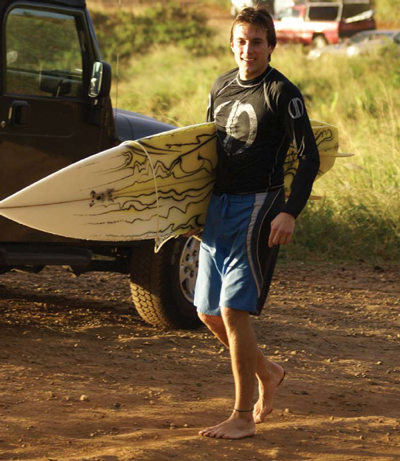As I arrived at Stinson Beach, I noticed the sign warning of a great white shark sighting and an attack that had occurred at the beach. I wished that sign had been there years ago. Even if it had been, I’m not sure it would have kept me out of the water. At the time, I could not have imagined what a shark attack was really like. Did a shark bite like a dog or did it try to eat people, like in the movies? Besides, before the sign was posted, there had never been a shark attack at Stinson anyway, so what was there to worry about?
Well, that was then. It was different now.
The film crew sat me down on the sand and started asking questions
“How old were you?”
“I was 16.”
“When did it happen?
“Wednesday, August 26, 1998, at 1:30 p.m.”
I responded with surprising detail.
“What were you doing and where?”
“I was boogie-boarding straight out from the main lifeguard tower with my friend Sean. Then he got out of the water, but I stayed in the same area and caught a few more waves alone.”
Suddenly, I went on to recount, my hand brushed something beneath the surface. It felt large and solid. It felt rough like wet sand. I looked but did not see anything. It was a feeling I’d had before—when I was water-skiing on a lake, swimming in a river or even in a pool. For a brief instant my imagination went out of control. Images of all sorts of terrifying sea creatures popped into my head, and some less terrifying ones.
I was a competitive swimmer, both in high school and in the Marin Swim League, and was very comfortable in the water. I tried to push my fear aside.
Now the fear was real. I hoped it was a seal or jellyfish. Something was there. I tried to keep my cool. Later, though, I learned that I was already yelling for help when Sean, standing on the beach, saw me disappear underwater in a splash. Subconsciously I knew the inevitable.
The 12-foot shark attacked from below and behind. It bit into my right leg, its jaws reaching from knee to hip, clamping down firmly on my bone. The impact was swift. The pain was intense. I felt a rigid shaking throughout my body. This thing was far too large to fight. I just hoped I could hold on.
After trying unsuccessfully to grab the shark in a bear hug, I squeezed its gills like handlebars on a bike. It let go and I swam furiously to shore.
The recovery process was long. I avoided Stinson. The memory of the shark was too vivid. The first time I returned was for a television interview a year after my attack.
Most people tend to shut down after a trauma. They prefer not to speak about what happened. The irony, of course, is that talking and sharing with others helps you heal. I was lucky. I was immediately given the chance to share my story with others. It became easier and easier, a sort of therapy. I was able to convert the fear of the attack into a positive force.
It took me a few years to realize the potential of my experience. The shark taught me a lesson. I just needed to listen. I had something I could use to help others.
No one knows why this shark attacked me. Maybe it was a little cranky. Maybe it just wanted to know what I was. What I thought of as being eaten alive, it probably thought of as just another taste test in a lifetime of survival.
I didn’t need to seek retribution for something that was at best an accident and at worst an animal doing what nature intended it to do. I began thinking about how to apply this lesson on a human level. The situation is common. Someone hurts us, we hurt them back, they hurt us back, we hurt them, et cetera—a destructive spiral in which everyone loses. Human nature makes us so determined to overcome and prevail that we often don’t stop to think about the mess we are creating.
We need to stop all this selfish revenge. We don’t need to fear sharks; we need to understand them. The best place to start is by teaching, and better yet, teaching children. I wrote Don’t Fear the Shark for children so they will think about their own actions before attacking someone else for theirs. Kids get it. They know what it is like to be targeted or picked on. What they need to learn is how to react respectfully.
If I had one thing I would tell someone who is afraid of sharks, it would be, “Don’t fear the shark. Be prepared for it. Understand it. Don’t live with hate and fear. Get back out there in the water. I’ll see you out there.”
Don’t Fear the Shark, Jonathan Kathrein’s book, is illustrated by Robert Singler Jr., a local artist. They have been friends since attending Dixie Elementary School and Miller Creek Middle School, in San Rafael.


